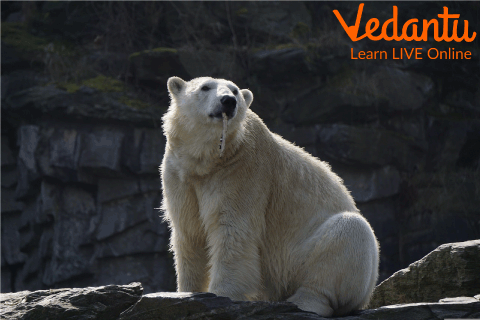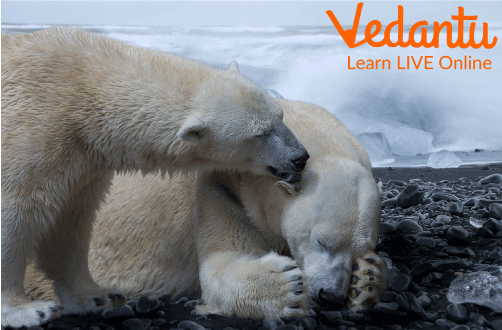




Introduction
What is the first thing that comes to your mind when you hear the name polar bear? White, furry bears, right? Polar Bears are large, primarily snow-white organisms which live in extremely cold climates and are usually found in the polar regions of the earth. They can survive in such cold weather because of their thick coat of fur. They usually feed on arctic foxes and the other organisms which live in the cold water around them.
In this article, we will discuss some interesting facts about polar bears and also some polar bear characteristics and polar bear special features.
Polar Bear Characteristics

Polar Bear
Polar bears have 42 teeth.
Polar Bears have very nice stamina, they can swim for days without getting tired.
Polar bears however cannot swim that fast. They can’t even outswim a seal in water which is why they mainly rely on their great sense of smell to catch their prey which is the seal.
Polar bears majorly have a high-fat diet, that is fat makes up more than half of their body weight.
Due to climate change, their population is slowly declining.
Polar Bear Special Features
A polar bear’s skin is black even though its thick coat of fur may appear to be white, it is in reality transparent.
A male polar bear can weigh up to 680 kg, however, female polar bears rarely weigh up to even half of that.

Male and Female Polar Bears
They have almost a 10 cm thick bubbler skin which is majorly responsible for keeping them warm.
Polar bears have an excellent sense of smell, they can detect a smell from as far away as a mile, which is 1.6 km.
Interesting Facts About Polar Bears
Some facts about Polar Bear are mentioned below:
Polar bear lives in the Arctic regions.
It is the largest carnivore that lives on land.
They can eat organisms like arctic foxes, but most of their diet consists of seals.
The scientific name for polar bears is ‘Ursus maritimus’.
Scientists claim that there are only 20000 polar bears in total, on earth.
A polar bear was a mascot in the winter Olympics of 1988, which took place in Canada.
A group of polar bears is known as a pack or a sleuth.
Sample Questions
State whether the statements mentioned below are true or not:
1. Polar bears live in extremely cold climates.
Ans: True.
2. They are usually white.
Ans: False, they are black but they appear to be white since their fur is translucent, which reflects the white snow.
3. Their main food is the arctic fox.
Ans: False, they mainly depend on seals as primary source of their food.
4. They cannot outswim a seal.
Ans: True.
Learn By Doing
Complete the statements that follow by filling in the blanks:
1. Male Polar Bears weigh up to _______ kgs.
Ans: 680
2. Polar Bears have _____ teeth.
Ans: 42
3. Polar Bears have a thick layer of _____ which helps them survive in the cold.
Ans: bubbler
Summary
Polar Bears are huge organisms which appear to be white but are black, and are primarily found in extremely cold climates of the arctic or the polar regions. They have huge bodies and mainly rely on seals living in the water around them as a source of food. They have a very nice sense of smell which help them in hunting seals since they are slower swimmers. They also have thick bubbler fat which helps them survive in the extremely cold climate by keeping them warm.
FAQs on Facts About Polar Bears for Kids
1. How long does the cub of a polar bear stay with its mother?
Once a polar bear cub is born it stays with its mother for almost five years. After that time when it is mature enough to survive on their own in the wild, they leave their mother’s side.
2. Can polar bears swim?
Polar bears can swim up to 6 mph, and they can also swim for long distances and long hours. Their large paws are well adapted for swimming.
3. Talk about a polar bear’s lifespan.
Polar bears can live up to 25 to 30 years in the wild. However, only a small percentage of polar bears live beyond the age of 15 to 18 years. The oldest living polar bear lived up to the age of 32 years.









